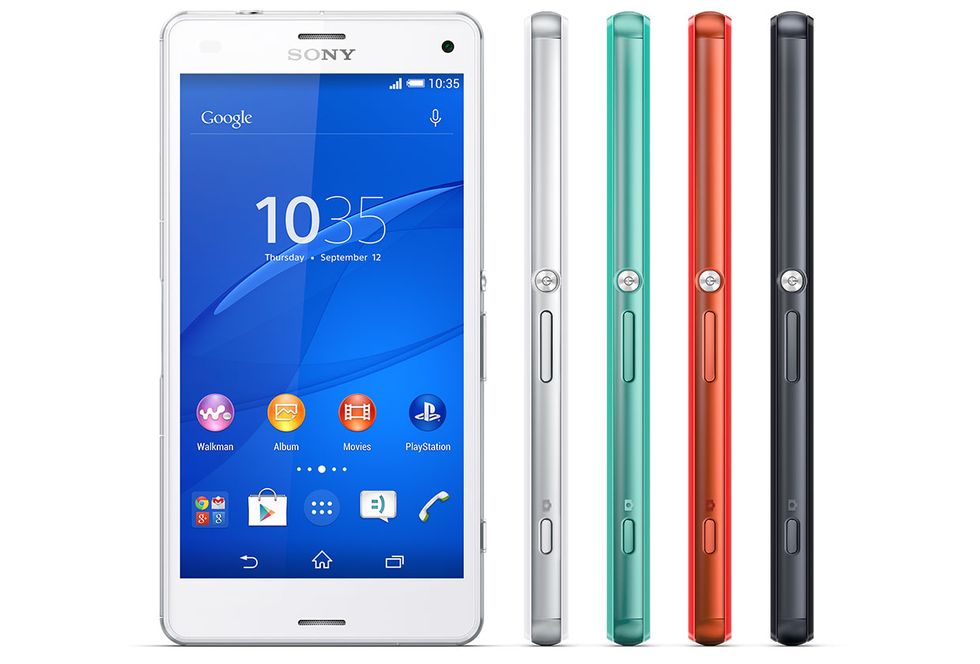Sony decided it would be a good idea to release a flagship device every six months. Although this has probably upset Xperia Z2 owners, who are already behind the curve before getting a third of their way through a contract, it does mean we have two new devices to choose from.
The first was the Sony Xperia Z3 - the top-spec, Xperia Z2-replacing monster we reviewed recently. And loved very much. The Xperia Z3 Compact, as the name suggests, is a more hand-friendly version. It's cheaper, too. So is it any good?
Design
The first impression we had, and others we showed the Xperia Z3 Compact to, was that it looks and feels like a lighter version of the iPhone 4 or 4S. Similar dimensions are probably to blame, but the squared-off edges and white paintjob play a role.
This is no bad thing, because the iPhone 4 was a fantastic device. In many ways the Z3 Compact adds a lot of what iPhone users would find useful, like the waterproof IP65 and IP68 rating that lets you take it underwater up to 1.5 metres deep for up to 30 minutes. So you could use it in the shower or take photos in the sea.
This is largely thanks to covers made from a frosted plastic that looks great and is said to reduce the effect of a drop. Behind one cover is a microSD slot (up to 128GB supported) and micro USB charging port so you can easily add or remove storage space. The other hides the nano SIM slot.
A Sony Xperia Z3 Compact lives up to its name by weighing a measly 129g. Measurements of 127 x 64.9 x 8.6mm and a 4.6-inch display make it substantially smaller than its more powerful Z3 sibling. This makes it more pocketable and better for one-handed use or for people with smaller digits.
A 4.6-inch display is less effective if you spend all your time playing games and watching Netflix on the go, but those tired of the trend in giant devices will find the Z3 Compact a breath of fresh air.
It helps that Sony has bundled in active noise-cancellation if you use the Sony NC31E headphones. It seems some markets get these in the box so you can enjoy the benefits of less background noise. Our review sample (and the Xperia Z3) lacked them.
In addition, you can play 'HD' MP3 files for a better sound. Normal MP3s are up-scaled to sound better. While it all depends on your ears and headphones as to whether you will notice a difference, sound quality has always been a big plus for Sony smartphones and the same is true here.
The slippery back does make it easy to drop and there are devices out that feel more solid. But it lived to tell the tale on two instances of cack-handedness. Just remember to ensure the covers are fully closed before taking the Z3 Compact with you into the bath.
Performance
The Sony Xperia Z3 Compact is £80 cheaper (SIM free) than the Z3 so it's no surprise the specs are slightly less impressive. But let's be clear, this is still a rapid device and one that, for its size, punches above the competition.
You get the same Qualcomm Snapdragon 801 processor, which is quad core and clocked at 2.5GHz. Combined with 2GB of RAM (1GB less than the Z3) and you can see why it outclasses rivals like the more expensive Samsung Galaxy Alpha. A HTC One Mini 2 and Samsung Galaxy S5 Mini are off the pace, too.
Although specs are meaningless inthemselves, the Z3 Compact feels virtually as snappy as its Z3 sibling and on a par with a flagship Android smartphone. Going vanilla Android will always mean a crisper, smoother experience but Sony's custom overlay is a pleasure to use.
Loading up the camera, for instance, takes less than a second so you can be ready to take the photo you want. Apps load up in rapid fashion and navigating the user-interface is only met with the slightest hesitance every now and then. Android is rarely as smooth as Windows Phone or iOS, but it's close enough.
Display
Another area where the Z3 Compact had to compromise a bit is the display. At 4.6 inches, it is 0.6 inches smaller than the Z3 but still good enough for readability. A 720p resolution (1,280x720-pixel) means no full HD goodness.
To be fair, the smaller display area helps give the Z3 Compact a pixel-per-inch score of 319, which is what you get on the iPhone 6 (326ppi). A Samsung Galaxy Alpha offers 313ppi. Only your full HD devices like the Galaxy S5 (432ppi) and Xperia Z3 (424ppi) put it to shame.
In reality the Xperia Z3 Compact is wonderfully bright, produces pleasing colours that are neither too garish nor too cold, and is more than adequate in the detail stakes. The viewing angles are pretty good, too. As displays go, especially in a phone this size, the end result is excellent.
Operating system
Our biggest gripe with the Sony Xperia is that the user-interface is a bit dated-looking. While iOS has borrowed a lot of the uncluttered, bold design cues seen on Windows Phone and Android phones like Asus have adopted much cleaner approaches to interface design, Sony has kept things very familiar.
This is no bad thing if you have come from a Sony device and anyone that hasn't will find Android 4.4.4 KitKat a pleasure to use in its custom guise. It's just as customisable and functional as the competition.
Perhaps it's just years of reviewing Sony phones that has given us a jaded outlook. The operating system rarely frustrates. Android, meanwhile, offers more apps and games than you would ever need so expect to be entertained for a very long time.
There are a few new additions to mull over, including an improved version of the Sony Album. You now get a short video summary, for instance, which is handy for finding the video you want to watch. There's also PS4 Remote Play, which we were unable to test. This lets you use your phone as a display when attached (via a special accessory) to a PS4 DualShock controller. It will be released later this year.
Elsewhere there's a fair bit of Sony bloatware to ignore. You would be better served by third-party app alternatives in most cases. Still, nothing to lose sleep over.
Camera
Not only does the Sony camera load up quickly, the 20.7-megapixel camera with autofocus takes fantastic shots. Like the Xperia Z3, it could be a bit better at low-light shooting, especially if you are used to Optical Image Stabilisation on a Nokia Lumia, but consider us very impressed.
The autofocus is nice and snappy, while the colours are captured naturally. Photos look refreshingly sharp. Like the Xperia Z3, the camera is extremely capable. Helpful on-screen hints the first time you use it are a nice bonus.
If we had to pick one fault, it's that the manual camera settings mode is behind that of a Nokia Lumia and iPhone 6, mainly because it's less easy to find what you need in the case of the latter comparison and there's less control over all the camera settings in the case of the former.
A few modes are noteworthy and one not so much. There is access to 12,800 ISO, which means really low-light shooting but the noise is very strong and so we would keep to the typical 3,200 ISO maximum at best, preferably lower.
TimeShift lets you record video at a higher frame-rate (120fps) so you watch it back in slow-motion. Not only is this feature extremely easy to use, it was immensely satisfying to behold.
Meanwhile Sony's SteadyShot is said to take out the effects of camera shake. Our movies did seem smooth even if we were walking and filming, while general hand shakiness seemed to be handled competently.
4K video is another plus point. While 4K video is still in its infancy, content is limited and devices capable of playback are few and far between (the Z3 Compact's display is unsuitable, for starters), at least you have the option. 4K aside, the video quality is top-notch. Full 1080p at 60fps is available within the manual mode if you want to go beyond 30fps.
At the front is a 2.2-megapixel camera for video calls and selfies. Again, the quality is impressive. Even though there are better 'selfie' cameras with higher megapixel counts, the detail is easily good enough.
Battery
Like the Sony Xperia Z3, the Xperia Z3 Compact earns major brownie points for lasting a day of heavy use easily. The 2,600mAh battery really took a beating, leaving us wondering why we ever put up with midday charges. We saw two days of use on a few occasions, which was bliss.
The Xperia Z3 Compact is, therefore, fantastic for anyone tired of having to find a plug socket just so the phone can last into the evening. Make use of the Stamina mode and you can really eke out every last drop with impressive results, although we never felt the need to use it.
Verdict
By focussing on the areas that really matter, like an impressive camera and superb battery life (for a smartphone), Sony deserves recognition. The Xperia Z3 and Z3 Compact are very accomplished Android smartphones that can survive most of what life throws at them.
We love both devices but the Xperia Z3 Compact comes out on top for us, mainly because it's cheaper but really no less impressive. We love the fact it's compact, yet still effortlessly fast. Sizing down no longer means compromising on performance.
Shop around and the Xperia Z3 Compact can be had for £340. For that reason we have no qualms giving it a full five star rating. Just mentally prepare yourself for the fact it will probably be outdated in March 2015.














![Chris Hemsworth Bad Times at the El Royale dance [gif] Chris Hemsworth Bad Times at the El Royale dance [gif]](https://hips.hearstapps.com/digitalspyuk.cdnds.net/18/41/1539256413-chris-hemsworth-bad-times-el-royale-dance.gif?crop=0.4074074074074074xw:1xh;center,top&resize=360:*)


